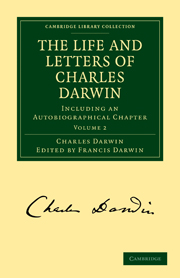Book contents
- Frontmatter
- Contents
- ERRATA
- CHAPTER I THE FOUNDATIONS OF THE ‘ORIGIN OF SPECIES’—1837–1844
- CHAPTER II THE GROWTH OF THE ‘ORIGIN OF SPECIES’—1843–1856
- CHAPTER III THE UNFINISHED BOOK—MAY 1856–JUNE 1858
- CHAPTER IV THE WRITING OF THE ‘ORIGIN OF SPECIES’—JUNE 18, 1858–Nov. 1859
- CHAPTER V PROFESSOR HUXLEY ON THE RECEPTION OF THE ‘ORIGIN OF SPECIES’
- CHAPTER VI THE PUBLICATION OF THE ‘ORIGIN OF SPECIES’—OCT. 3, 1859–DEC. 31, 1859
- CHAPTER VII THE ‘ORIGIN OF SPECIES’ (continued)—1860
- CHAPTER VIII THE SPREAD OF EVOLUTION—1861–1862
CHAPTER I - THE FOUNDATIONS OF THE ‘ORIGIN OF SPECIES’—1837–1844
Published online by Cambridge University Press: 29 August 2010
- Frontmatter
- Contents
- ERRATA
- CHAPTER I THE FOUNDATIONS OF THE ‘ORIGIN OF SPECIES’—1837–1844
- CHAPTER II THE GROWTH OF THE ‘ORIGIN OF SPECIES’—1843–1856
- CHAPTER III THE UNFINISHED BOOK—MAY 1856–JUNE 1858
- CHAPTER IV THE WRITING OF THE ‘ORIGIN OF SPECIES’—JUNE 18, 1858–Nov. 1859
- CHAPTER V PROFESSOR HUXLEY ON THE RECEPTION OF THE ‘ORIGIN OF SPECIES’
- CHAPTER VI THE PUBLICATION OF THE ‘ORIGIN OF SPECIES’—OCT. 3, 1859–DEC. 31, 1859
- CHAPTER VII THE ‘ORIGIN OF SPECIES’ (continued)—1860
- CHAPTER VIII THE SPREAD OF EVOLUTION—1861–1862
Summary
[In the first volume, p. 82, the growth of the ‘Origin of Species’ has been briefly described in my father's words. The letters given in the present and following chapters will illustrate and amplify the history thus sketched out.
It is clear that, in the early part of the voyage of the Beagle he did not feel it inconsistent with his views to express himself in thoroughly orthodox language as to the genesis of new species. Thus in 1834 he wrote at Valparaiso: “I have already found beds of recent shells yet retaining their colour at an elevation of 1300 feet, and beneath the level country is strewn with them. It seems not a very improbable conjecture that the want of animals may be owing to none having been created since this country was raised from the sea.”
This passage does not occur in the published ‘Journal,’ the last proof of which was finished in 1837; and this fact harmonizes with the change we know to have been proceeding in his views. But in the published ‘Journal’ we find passages which show a point of view more in accordance with orthodox theological natural history than with his later views. Thus, in speaking of the birds Synallaxis and Scytalopus (1st edit, p. 353; 2nd edit. p. 289), he says: “When finding, as in this case, any animal which seems to play so insignificant a part in the great scheme of nature, one is apt to wonder why a distinct species should have been created.”
- Type
- Chapter
- Information
- The Life and Letters of Charles DarwinIncluding an Autobiographical Chapter, pp. 1 - 18Publisher: Cambridge University PressPrint publication year: 2009First published in: 1887

